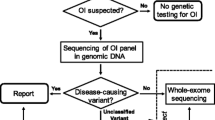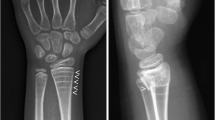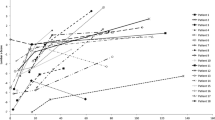Abstract
Summary
This retrospective study on long-term outcomes in osteogenesis imperfecta type VI found that patients who received intravenous bisphosphonate treatment had an increase in lumbar spine areal bone mineral density, a higher final height z-score, and some reshaping of vertebral bodies.
Introduction
Osteogenesis imperfecta (OI) type VI is an ultra-rare bone fragility disorder caused by recessive mutations in SERPINF1. Here, we describe long-term outcomes in OI type VI and compare the clinical phenotypes caused by different types of SERPINF1 mutations.
Methods
This study includes a retrospective chart review of 13 individuals with OI type VI.
Results
In the absence of therapy, lumbar spine areal bone mineral density (BMD) did not increase during childhood and longitudinal growth seemed to stall after the age of 6 to 8 years. The phenotype was similar between individuals with different types of SERPINF1 mutations. Intravenous bisphosphonate treatment was associated with an increase in lumbar spine areal BMD and some reshaping of compressed vertebral bodies. Patients who had started bisphosphonate treatment early (before the age of 6 years) were taller than patients who had received bisphosphonate treatment later during their growing years. Lower extremity fractures were frequent despite bisphosphonate treatment and scoliosis was present in all patients who had reached the final height. Most patients had restricted mobility. In four patients, intravenous bisphosphonate treatment was eventually substituted by subcutaneous injections of denosumab, without clear changes in the clinical picture.
Conclusions
Patients with OI type VI who received intravenous bisphosphonate treatment during growth had an increase in lumbar spine areal BMD, a higher final height z-score, and presented some reshaping of vertebral bodies. More effective treatment modalities are clearly required in OI type VI.



Similar content being viewed by others
References
Bardai G, Moffatt P, Glorieux FH, Rauch F (2016) DNA sequence analysis in 598 individuals with a clinical diagnosis of osteogenesis imperfecta: diagnostic yield and mutation spectrum. Osteoporos Int 27:3607–3613
Trejo P, Rauch F (2016) Osteogenesis imperfecta in children and adolescents-new developments in diagnosis and treatment. Osteoporos Int 27:3427–3437
Glorieux FH, Ward LM, Rauch F, Lalic L, Roughley PJ, Travers R (2002) Osteogenesis imperfecta type VI: a form of brittle bone disease with a mineralization defect. J Bone Miner Res 17:30–38
Becker J, Semler O, Gilissen C et al (2011) Exome sequencing identifies truncating mutations in human SERPINF1 in autosomal-recessive osteogenesis imperfecta. Am J Hum Genet 88:362–371
Homan EP, Rauch F, Grafe I et al (2011) Mutations in SERPINF1 cause osteogenesis imperfecta type VI. J Bone Miner Res 26:2798–2803
Al-Jallad H, Palomo T, Roughley P, Glorieux FH, McKee MD, Moffatt P, Rauch F (2015) The effect of SERPINF1 in-frame mutations in osteogenesis imperfecta type VI. Bone 76:115–120
Palomo T, Fassier F, Ouellet J, Sato A, Montpetit K, Glorieux FH, Rauch F (2015) Intravenous bisphosphonate therapy of young children with osteogenesis imperfecta: skeletal findings during follow up throughout the growing years. J Bone Miner Res 30:2150–2157
Montpetit K, Palomo T, Glorieux FH, Fassier F, Rauch F (2015) Multidisciplinary treatment of severe osteogenesis imperfecta: functional outcomes at skeletal maturity. Arch Phys Med Rehabil 96:1834–1839
Land C, Rauch F, Travers R, Glorieux FH (2007) Osteogenesis imperfecta type VI in childhood and adolescence: effects of cyclical intravenous pamidronate treatment. Bone 40:638–644
Baron R, Ferrari S, Russell RG (2011) Denosumab and bisphosphonates: different mechanisms of action and effects. Bone 48:677–692
Hoyer-Kuhn H, Netzer C, Koerber F, Schoenau E, Semler O (2014) Two years’ experience with denosumab for children with osteogenesis imperfecta type VI. Orphanet J Rare Dis 9:145
Ogden CL, Kuczmarski RJ, Flegal KM, Mei Z, Guo S, Wei R, Grummer-Strawn LM, Curtin LR, Roche AF, Johnson CL (2002) Centers for Disease Control and Prevention 2000 growth charts for the United States: improvements to the 1977 National Center for Health Statistics version. Pediatrics 109:45–60
Salle BL, Braillon P, Glorieux FH, Brunet J, Cavero E, Meunier PJ (1992) Lumbar bone mineral content measured by dual energy X-ray absorptiometry in newborns and infants. Acta Paediatr 81:953–958
Southard RN, Morris JD, Mahan JD, Hayes JR, Torch MA, Sommer A, Zipf WB (1991) Bone mass in healthy children: measurement with quantitative DXA. Radiology 179:735–738
Glastre C, Braillon P, David L, Cochat P, Meunier PJ, Delmas PD (1990) Measurement of bone mineral content of the lumbar spine by dual energy x-ray absorptiometry in normal children: correlations with growth parameters. J Clin Endocrinol Metab 70:1330–1333
Genant HK, Wu CY, van Kuijk C, Nevitt MC (1993) Vertebral fracture assessment using a semiquantitative technique. J Bone Miner Res 8:1137–1148
Minne HW, Leidig G, Wuster C, Siromachkostov L, Baldauf G, Bickel R, Sauer P, Lojen M, Ziegler R (1988) A newly developed spine deformity index (SDI) to quantitate vertebral crush fractures in patients with osteoporosis. Bone Miner 3:335–349
Glorieux FH, Travers R, Taylor A, Bowen JR, Rauch F, Norman M, Parfitt AM (2000) Normative data for iliac bone histomorphometry in growing children. Bone 26:103–109
Bleck EE (1981) Nonoperative treatment of osteogenesis imperfecta: orthotic and mobility management. Clin Orthop Relat Res:111–122
Haley SM, Coster WJ, Ludlow LH, Haltiwanger JT, Anrellos PJ (1992) Pediatric evaluation of disability inventory (PEDI): development, standardization and administrative manual. New England Medical Center, Boston
Zeitlin L, Fassier F, Glorieux FH (2003) Modern approach to children with osteogenesis imperfecta. J Pediatr Orthop B 12:77–87
Black DM, Rosen CJ (2016) Clinical practice. Postmenopausal osteoporosis. N Engl J Med 374:254–262
Rauch F, Husseini A, Roughley P, Glorieux FH, Moffatt P (2012) Lack of circulating pigment epithelium-derived factor is a marker of osteogenesis imperfecta type VI. J Clin Endocrinol Metab 97:E1550–E1556
Ward L, Bardai G, Moffatt P, Al-Jallad H, Trejo P, Glorieux FH, Rauch F (2016) Osteogenesis imperfecta type VI in individuals from Northern Canada. Calcif Tissue Int 98:566–572
Trejo P, Fassier F, Glorieux FH, Rauch F (2017) Diaphyseal femur fractures in osteogenesis imperfecta: characteristics and relationship with bisphosphonate treatment. J Bone Miner Res 32:1034–1039
Folkestad L, Hald JD, Ersboll AK, Gram J, Hermann AP, Langdahl B, Abrahamsen B, Brixen K (2017) Fracture rates and fracture sites in patients with osteogenesis Imperfecta: a nationwide register-based cohort study. J Bone Miner Res 32:125–134
Fratzl-Zelman N, Schmidt I, Roschger P, Roschger A, Glorieux FH, Klaushofer K, Wagermaier W, Rauch F, Fratzl P (2015) Unique micro- and nano-scale mineralization pattern of human osteogenesis imperfecta type VI bone. Bone 73:233–241
Obafemi AA, Bulas DI, Troendle J, Marini JC (2008) Popcorn calcification in osteogenesis imperfecta: incidence, progression, and molecular correlation. Am J Med Genet A 146A:2725–2732
Sato A, Ouellet J, Muneta T, Glorieux FH, Rauch F (2016) Scoliosis in osteogenesis imperfecta caused by COL1A1/COL1A2 mutations—genotype-phenotype correlations and effect of bisphosphonate treatment. Bone 86:53–57
McClung MR, Lewiecki EM, Cohen SB et al (2006) Denosumab in postmenopausal women with low bone mineral density. N Engl J Med 354:821–831
Acknowledgments
We thank Mark Lepik for the preparation of the figures. The study was supported by the Shriners of North America.
Author information
Authors and Affiliations
Corresponding author
Ethics declarations
Conflicts of interest
The authors state that they have the following disclosures:
Pamela Trejo: None
Telma Palomo: None
Kathleen Montpetit: None
François Fassier: Péga Médical: Royalties
Atsuko Sato: None
Francis H. Glorieux: Novartis and Mereo Biopharma: Consulting fees, Amgen: Research grants
Frank Rauch: Ultragenyx Inc.: Study grant to institution; Alexion Inc.: Study grant to institution
Additional information
This study was supported by the Shriners of North America.
Rights and permissions
About this article
Cite this article
Trejo, P., Palomo, T., Montpetit, K. et al. Long-term follow-up in osteogenesis imperfecta type VI. Osteoporos Int 28, 2975–2983 (2017). https://doi.org/10.1007/s00198-017-4141-x
Received:
Accepted:
Published:
Issue Date:
DOI: https://doi.org/10.1007/s00198-017-4141-x




